
La Crosse's German Vereins: Their Rise and Decline, Part 1
(Written by Gabriel Eagon, UWL Capstone Project, edited by Jenny DeRocher, Archives Staff)
Many readers will no doubt be familiar with La Crosse’s German roots, thanks to the city’s brewing industry and annual Oktoberfest celebration. However, these traditions are just a small part of the story of La Crosse’s German heritage. In fact, Oktoberfest was first inaugurated in the 1960s, over 100 years after the first Germans began to settle in La Crosse. So how did early German immigrants socialize and try to preserve their culture until then? Many did so through the creation of societies or clubs called Vereins in their native German. For nearly 80 years these Vereins occupied a central role in the social lives of many of La Crosse’s Germans, and their rise and fall will be the topic of the next two La Crosse Public Library Archives “Our Stories” blogs.
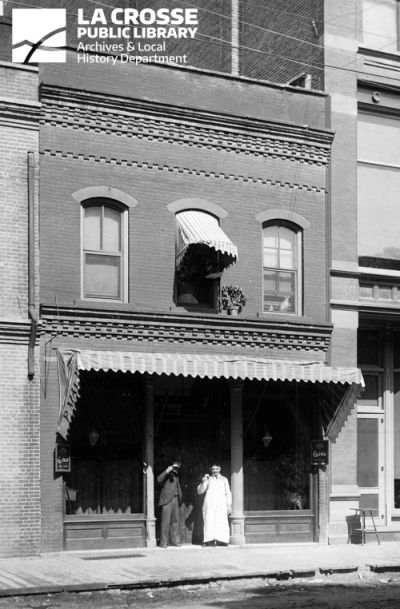
Two men toasting some German beer to a photographer in front of the Paul Malin Sample Room at 120 S. 4th St. (this building is now part of the Bodega establishment). The signs to the left and right show that Malin proudly served Gund beer, brewed here in La Crosse. Gund also brewed the beer of choice for both the Frohsinn Singing Society and the Deutscher Verein.
The first major wave of German immigrants arrived in La Crosse in the 1850s. Some came as political refugees, like the so-called Forty-Eighters, while others came for economic reasons. It was not long before they began to create clubs and societies that had been popular in their original homeland. In 1855 a group of La Crosse Germans founded the La Crosse Turnverein (a gymnastics society). The goal of Turnvereins was to promote a sound mind and body through physical activity and by having lively discussions on politics and other topics. Turnvereinswere incredibly popular among German immigrants throughout the United States and La Crosse was no exception.
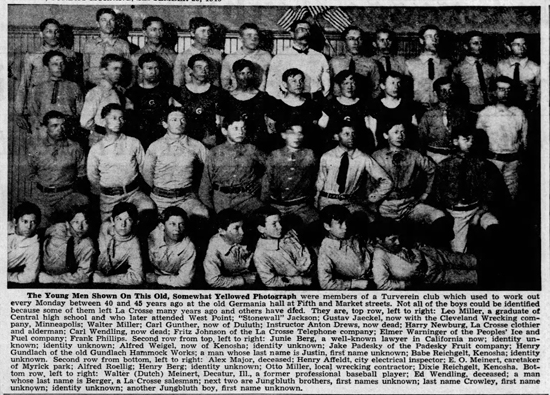
The La Crosse Tribune printed this photo of the Turverein on September 29, 1946, page 14. It was reported that the old, yellowed photograph had recently been found. It is likely from circa 1900, according to the caption.
Another popular type of German Verein were Gesangvereins (singing societies).The city’s first German signing society was the Liederkranz, founded in 1856 after a rift occurred between older and younger members of the city’s Turnverein. The older members wanted to keep their focus on gymnastics, while the younger members wanted to practice singing.
Singing societies have a long history dating back to the 16th century in Germany. Rather than practice German folk songs as one might expect, they typically worked on perfecting classical music pieces written by famous composers like Beethoven, Brahms, and Hyden. These societies put on concerts and would compete against other singing societies in regional singing competitions known as Saengerfests. The La Crosse Turnverein and Liederkranzwould continue as separate organizations until 1874, when they put aside their differences and combined to form the Deutscher Verein.
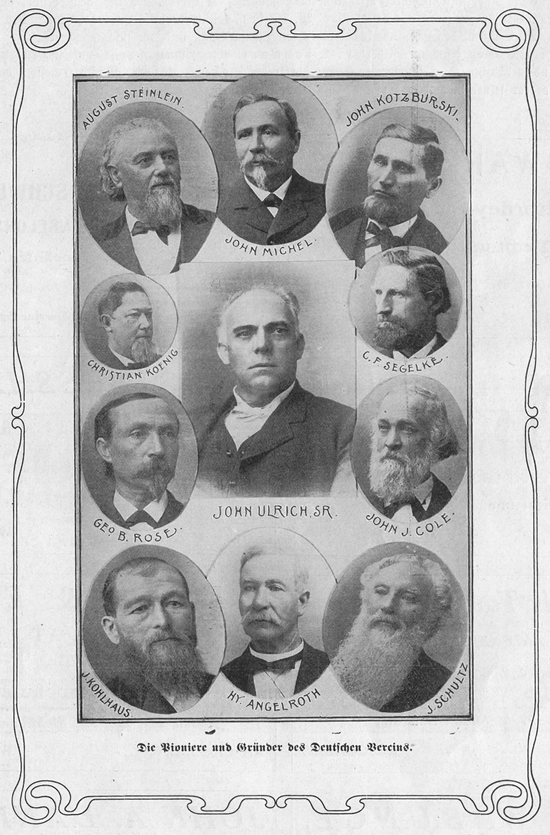
Founders of Deutscher Verein, printed in the 1907 Nordstern“50th Anniversary Edition”, page 67.
Throughout the second half of the 19th century, as more German immigrants arrived, other social Vereins formed in La Crosse. By 1900, there were at least seven in the city, most of which were singing societies. The largest and most prominent was the Deutscher Verein, whose members even owned and operated their own building called Germania Hall on 4th and Market St. (where the fire station currently is). Another prominent Verein was the Frohsinn Singing Society which would eventually grow to be the second largest Verein in La Crosse after the Deutscher Verein. In addition to their stated goals of promoting gymnastics and singing, these societies served as places for German immigrants to socialize with fellow Germans in their native language and preserve their culture, often while enjoying good beer.
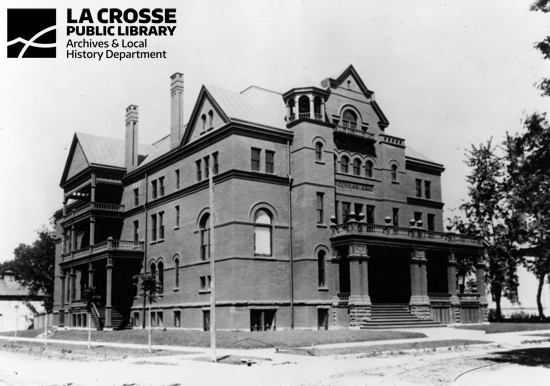
Germania Hall was located at 720 S. 5th Avenue. It was demolished in 1966 to make way for the fire station.
However, in the early 20th century, the tides began to change for La Crosse’s German societies. By 1920, the number of German social Vereins in La Crosse had fallen to just three. It is easy to assume that WWI—and the anti-German sentiment the war provoked—were the sole cause of the decline of La Crosse’s German societies. However, the decline of La Crosse’s German societies had in fact already begun nearly 20 years earlier, and WWI was just a contributing factor to an already existing trend.
There were two primary factors responsible for the decline of La Crosse’s German societies. The first was that German immigration rates to La Crosse slowly dwindled. Throughout the second half of the 19th century, successive waves of German immigrants had always arrived in enough numbers to replace aging members of the German societies. But by the 1890s the turbulent economic and political conditions that had motivated so many Germans to emigrate began to stabilize, and German immigration slowed to a trickle by the early 20th century. The Nordstern, La Crosse’s German language newspaper described the result in bleak terms in its 1907 20th anniversary edition:
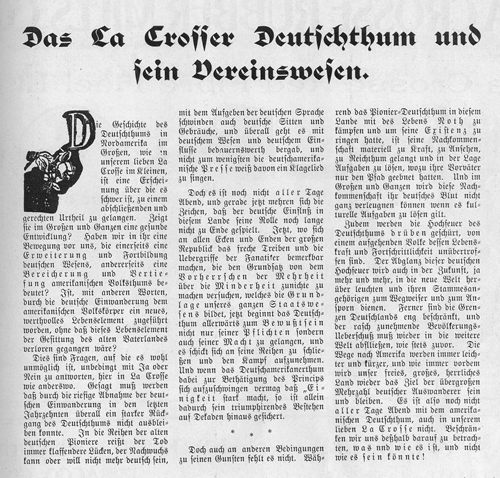
Translation (second paragraph, starting in column 1): "It must be said that through the massive decline in German immigration in the last ten years, it was not possible to avoid a strong decline of Germanness. Death is constantly taking away the old German pioneers, and their descendants cannot or no longer want to be German. With the loss of the German language are German customs lost also, and German ways and German influences are unfortunately on the decline." Printed in the 1907 Nordstern “50th Anniversary Edition”, page 65. Translated by Gabriel Eagon.
Translation: It must be said that through the massive decline in German immigration in the last ten years, it was not possible to avoid a strong decline of Germanness. Death is constantly taking away the old German pioneers, and their descendants cannot or no longer want to be German. With the loss of the German language are German customs lost also, and German ways and German influences are unfortunately on the decline.
This quote also mentions the second factor that contributed to the decline of La Crosse’s German societies: the fact that the descendants of the German pioneers “cannot or no longer want to be German.” The early twentieth century was a time of increased consumerism that provided opportunities for young second-generation Germans to be drawn away from the Vereins. For example, movie theaters, bowling alleys, and dance halls might have attracted younger descendants of German immigrants far more than the traditional Vereins. Despite this, a few Vereins, including the Deutscher Verein and Frohsinn Singing Society, found ways to survive this initial decline.
For a time, it looked as if the Deutscher Verein might suffer the same fate as so many other local German societies. Between 1900 and 1910, they lost 141 members and had just 108 left in 1910. However, in 1910, Herman O. Klein was elected as the society’s new president. Klein embarked on a number of initiatives that helped them regain lost members and attract new ones.
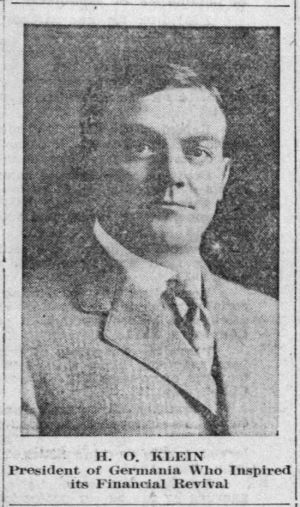
A photo of Herman O. Klein printed in the La Crosse Tribune on October 19, 1912, page 9.
The first change was major renovations to Germania Hall. A May 6, 1910 La Crosse Tribune article described how the society invested $5,000 into “new decorations, a complete rearrangement of the north end of the first floor, a new kitchen, grill room, changes in the lockers and baths in the gymnasium and a ventilation system in the bowling alley.” In addition to these costly renovations, the society would expand its social offerings to include dances, orchestra concerts, card tournaments, bowling tournaments, and other social functions to use entertainment to attract a younger demographic.

La Crosse Tribune, May 6, 1910, page 4.
Klein’s innovations were a success, and by 1911, they added 108 members. Moreover, the activities like dancing, bowling, and card playing that helped reinvigorate the society's appeal was not limited to just Germans, and the society began to attract non-Germans for the first time. The society's membership applications reveal that it had begun to attract a multi-ethnic membership base that included names like Johnson, Puckett, and Olsen which were British, French, and Scandinavian in origin.
However, this success came at the cost of some of the more traditional German activities, like gymnastics and singing. And while the club’s ability to attract a multi-ethnic membership allowed for their survival long into the future, it also raised questions about whether the club might assimilate so much that it ceased being a German society.
In contrast, the Frohsinn Singing Society remained staunchly committed to its German roots. Between 1900-1914, as interest in Saengerfests waned among La Crosse’s other German singing societies, the Frohsinns would continue to send delegations to represent the city. At the 1906 Saengerfest held in St. Paul, John Malin, president of the Frohsinn Singing Society even volunteered La Crosse to host the next Saengerfest in 1908.
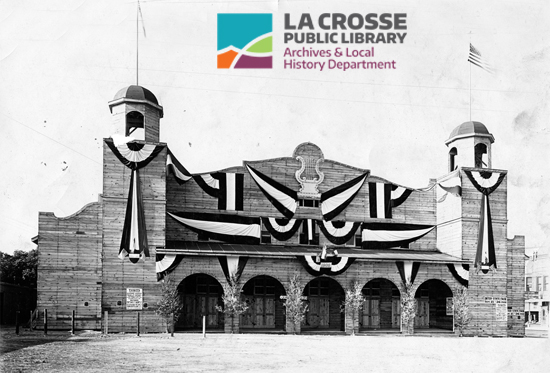
The newly-built auditorium for Saengerfest in 1908. This building was temporarily located in Market Square, which was on 4th St. in between King and Jay streets.
The Frohsinn Singing Society’s willingness to invest so much time and effort into making the event a success, and their continued participation in Saengerfests throughout the 1910s, evidenced their commitment to German culture. While their tactics differed from the Deutscher Verein, this group too survived the larger decline of La Crosse’s Vereins and had a membership that hovered around 99 members between 1905 and 1914, demonstrating that there was still enough interest in the German language and culture to sustain such a club. However, since they were unwilling to assimilate like the Deutscher Verein, they would be forced to rely on continued German immigration in order to survive into the future, which raised doubts about the long-term viability of the club.
The first two decades of the 20th century was a difficult time for many of La Crosse’s German Vereins, but the Deutscher Verein and Frohsinn Singing Society both managed to survive. However, in 1914, World War I began and this event would have significant consequences for German Societies in La Crosse. To find out more about the effects of WWI on the Deutscher Verein and Frohsinn Singing Society, return for Part II of this blog series in two weeks (August 31, 2021).
